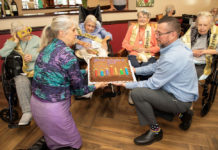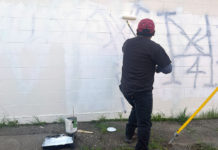Volunteers seeking 600,000 signatures by April 16 to get
Local Taxpayers and Public Safety Protection Act on November
ballot
by BERT WILLIAMS, News Editor
A movement is afoot across the state to give voters more control
over their tax dollars. Volunteers are intent on gathering the
signatures of at least 600,000 registered voters by mid-April to
qualify the Local Taxpayers and Public Safety Protection Act for
the November ballot.
Healdsburg Council- member Jason Liles said last week that, so
far, he has personally collected 30 signatures for the cause.
Statewide, a coalition of more than 250 organizations including
public safety agencies, city and county governments, business,
labor and taxpayer organizations and other districts and
associations have lined up to support the ballot initiative. Local
officials are solidly behind the effort.
“It’s very important that this initiative pass,” said Windsor
Mayor Debora Fudge. “We can’t afford to have more ‘take-aways’ from
our budget.”
Town Manager Paul Berlant recently told the Windsor Chamber of
Commerce that the state of California has taken away $1.75 million
from Windsor’s coffers during the past 12 years. Berlant said the
town has currently frozen spending on $1.2 million of its $20
million two-year budget, waiting to see how legislators resolve the
current state budget crisis, and how much more they take from city
and county budgets in their effort.
“The cities and the voters have never had a choice before,” said
Healdsburg Mayor Lisa Schaffner. “But the cities provide basic
services. I don’t know why someone wouldn’t support this.”
If passed, the Local Taxpayers and Public Safety Protection Act
will deny state legislators the right to raid local budgets in
their effort to balance the state budget, unless voters
approve.
“The state has balanced their budgets on the backs of local
governments for too long,” said Sonoma County Supervisor Paul
Kelley. “This inititative is trying to protect what revenues we
have left, so that we can do responsible budgeting in the
future.
On March 15, the Healdsburg City Council passed a resolution in
support of the ballot initiative. According to Liles, if the
initiative passes in November, it will give cities “constitutional
authority not to comply with the state” on budget matters, unless
voters approve the action.
The most common method by which local tax dollars have been
transferred to the state budget in recent years is known as the
“ERAF shift.” During a recession in the early 1990s, the
legislature began shifting some property tax revenues from city and
county budgets to local schools. This had the effect, not of giving
more money to schools, but of funding a higher percentage of school
budgets from local rather than state dollars. It was city and
county budgets that came up short.
The legislation that created the shift in funds was known as the
Educational Revenue Augmentation Fund (ERAF). According to League
of California Cities Regional Representative Amy O’Gorman, the ERAF
shift continued to take money from local budgets even during the
late ’90s, when the state was running a budget surplus. City
property tax shares across the state have been reduced by an
average of 24 percent by the ERAF shift.
The state’s Motor Vehicle License Fee (VLF) has also been kicked
around recently by state politicians, with negative consequences
for local governments.
Since 1948, the VLF had been set at two percent of a vehicle’s
price. The funds were collected by the state Department of Motor
Vehicles and allocated to city and county budgets.
In 1998, during the time of state budget surpluses, the VLF was
decreased to 0.65 percent, the resulting loss of funds being made
up to cities and counties from the flush state general fund.
But in 2003, faced with ballooning deficits, the state
legislature raised the VLF back to its earlier level. During his
campaign for governor, however, Arnold Scharzenegger pledged that,
if he was elected, he would roll back the VLF increase.
He was elected, and he did roll back the increase.
The governor promised that cities and counties would not be hurt
by the move, but, according to Berlant, the issue still has not
been resolved, and cities have been reduced to waiting and
wondering what will happen to their current budgets.
Concern about the budgets of local government entities is not
just a bureaucratic exercise. The budgets for fire departments,
police departments, street maintenance, libraries and parks are all
affected.
According to Windsor Fire Chief Ron Collier the Windsor Fire
Protection District has lost a total of $800,000 in ERAF shifts
over the years. The state legislators “have a license to steal,”
said Collier, “but we are required to balance our budget.”
“The state is still up to $14 billion in the hole even after
Proposition 57,” said Berlant, referring to the $15 billion bond
that voters passed in March. As a result, local officials fear that
state legislators will be looking for still more of the cities’ and
counties’ tax dollars.
According to Californians to Protect Local Taxpayers and Public
Safety, the ballot initiative that is being proposed will be
limited in its scope. It does not attempt to undo shifts in funding
that have already taken place – they will continue to take place.
And the initiative does not raise taxes.
“This measure was intentionally drafted to draw a line in the
sand and prevent future state legislative raids of local
government,” say the sponsors of the initiative. The effect of the
initiative, if passed, will be to use the 2003 state budget as the
baseline, denying further funding shifts unless voters approve
them.
State Senator Wes Chesbro, whose district includes northern
Sonoma County, is chair of the senate budget committee. He spent 17
years as a city and county elected official, and said he is
sympathetic to the needs of local governments. “Fire, police and
local roads should be the first priority for tax dollars,” he
insisted.
Given that, does Chesbro support a ballot initiative that would
limit his attempts to balance the state budget?
“I haven’t taken a stand at this point,” he said. “But ballot
box budgeting creates a greater set of problems. This is only one
of several budget initiatives on the November ballot.”
Chesbro said state legislators have been “boxed in” over the
years by ballot initiatives that restrict their control over the
budget process.
The proponents of the Local Taxpayers and Public Safety
Protection Act have already gotten the attention of the legislature
and the governor, according to Chesbro, and the impact is being
felt even before the November election.
“This has already had a beneficial effect, and it will help
cities and counties to protect their tax dollars in this year’s
budget,” he insisted.
Chesbro said he fears that, if the ballot initiative passes in
November, some portions of the budget, such as programs for the
developmentally disabled, will not be protected from deep cuts.
“They will be more at risk,” he said. “They’ll have to fight for
the remaining dollars.”
Local officials have differing views about the ballot
initiative’s prospects in the November election.
“When people understand what this is, I think we’ll get an
overwhelming response,” said Fudge.
“Everyone I’ve asked has been supportive,” said Schaffner.
But both Liles and Kelley are far from certain the initiative
will pass in November.
“There are a lot of people who do business with the state who
could view this as not in their interest,” said Liles, noting that
labor unions, in particular, could mount strong opposition. “It’s
really easy to confuse people in a campaign,” Liles said, “and it
wouldn’t shock me at all … if this campaign gets outspent.”
Kelley is also concerned. “There’s going to be a plethora of
initiatives on the November ballot,” he said. “It’s going to be a
challenge for voters to sort through them.”
Meanwhile promoters of the ballot initiative are focused on
getting the needed signatures by the April 16 deadline. Volunteers
mounted “signature-gathering blitzes” on March 13 and 27. “We’re
confident that we will have sufficient signatures to qualify for
the ballot,” said O’Gorman last week.
For more information about the Local Taxpayers and Public Safety
Protection Act visit www.protectlocalservices.com or call Amy
O’Gorman at (707) 291-3270.
44.5
F
Healdsburg
March 13, 2025








